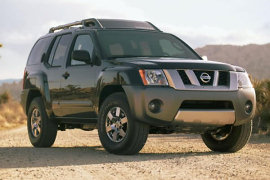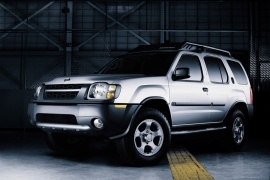NISSAN XTerra Models/Series Timeline, Specifications & Photos
First production year: 2002
Engines: Gasoline
Body style: SUV (Sports Utility Vehicle)
Following one of the oldest tricks in the SUV book, Nissan introduced the X-Terra's second generation in 2005 and improved it in 2009.
Most SUVs started as body-on-frame vehicles, and the X-Terra was no different. It shared its chassis with the Frontier pickup, and it showed it on the rear doors' shape. The carmaker built its chassis to carry heavy loads, so using it to transport just some people and bodywork was no trouble. But an SUV had to tick different boxes than a utility vehicle. That's why Nissan improved the Xterra in 2009 before it discontinued it six years later due to poor sales.
The exterior featured a new V-shaped grille that resembled a V engine, which it had. Underneath it, a unique-shaped front bumper sported two black outer parts and an aluminum shield in the middle, on the lower side. The carmaker added a set of lights on the roof and a roof rack for the off-road package. At the back, the Xterra featured the same bulky bumper with incorporated side-steps.
Inside, the new steering wheel gained four more buttons on the right spoke for the sound system. Nissan considered installing a Bluetooth connection on the entire range and offered that feature as standard. Like its non-facelifted version, the 2009 Xterra featured a folding system for the front passenger's seat, which allowed the owner to slide a surfboard from the trunk to the dash panel. On the center stack, the carmaker installed new climate control dials.
Under the hood, the carmaker kept the same engine, but it lost a few horses due to stricter emission regulations.
The second generation of the Nissan Xterra was unveiled at the 2004 New York Auto Show as a 2005 model year. It was based on a new platform and was offered with a new engine.
The second generation of the Xterra was based on the proven Nissan F-Alpha platform, which used a ladder-chassis with front independent suspension and a solid rear axle, or an independent suspension depending on the car. It was used for heavy vehicles such as Nissan Armada or the Patrol Y62 model. The Xterra was shorter and lighter than the above mentioned and that brought it some advantages.
From the outside, the Xterra was shaped with a step-up roof over the rear seats and the trunk, somehow like the second generation of the Nissan Terrano. The front side of the vehicle showed a complicated design formed by straight and angled lines across the grille and into the bumpers. The upper versions had the body-colored bumpers.
Interior flexibility has been enhanced in several ways as well. The 60/40 split-folding rear seat is joined by an available fold-down front passenger seat, creating more room for long items such as a canoe. The simple, four dials, design of the instrument cluster featured two additional LCD screens for the trip computer or the odometer. The center stack was organized around the audio system, with large and round knobs for climate control.
For the drivetrain, the Xterra was available in only one configuration, with e newly developed 4.0-liter V6 with variable camshaft timing mated to a standard 6-speed manual or an option for a 5-speed automatic. It was offered with a choice of part-time 4-wheel drive or 2-wheel drive.
After two years since the launch of the Xterra's first generation, Nissan unveiled the facelifted version for it at the Chicago Auto Show.
Nissan counted on its off-road experience when it made the Xterra. It was built on the same chassis as the Frontier pickup and was related to the European Pathfinder. It aimed at the X-generation, hence the X in its name, and tried to convince its customers that it could deal with more rugged terrain than its competitors. But being related to a utility vehicle came with a similar steering system cost and being heavier than other compact-segment SUVs.
The revised Xterra received a new front fascia with a V-shaped grille similar to other Nissan vehicles. Yet, its round headlights in squared clusters looked odd for a car launched in 2001. The flared wheel-arches for both axles made room for big, 265/65R 17 tires for the SE version and 265/70R 16 for the rest of the range. A new, 48 mm (1.9") bulge on the hood made room for a supercharger for the most potent version.
Inside, the carmaker introduced a new instrument panel with three round dials with the speedometer in the middle and the tachometer on the left. At the same time, the right cluster featured the fuel level and coolant temperature gauges. In addition, the redesigned center stack sported a side map pocket, while the glove compartment grew by 25%.
But the most significant changes were under the hood, where the carmaker offered a choice of three engines ranged between 143 hp and 210 hp. The latter was a supercharged V-6 powerplant, and it was available with a five-speed manual gearbox. In addition, depending on the options, Nissan installed either an open or a limited-slip differential for the rear axle.


